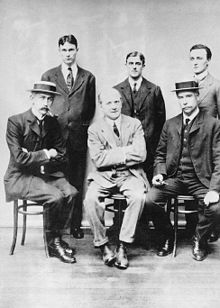- Diamond Jenness
-
Diamond Jenness 
University of Oxford Anthropology Diploma class of 1910-11. Jenness is in the center of the back rowBorn February 10, 1886
Wellington, New ZealandDied November 29, 1969
Chelsea, Quebec, CanadaEducation Victoria University College of New Zealand
Balliol College, Oxford UniversityOccupation Anthropologist Employer National Museum of Canada Known for Study of Copper Inuit Predecessor Dr. Edward Sapir Diamond Jenness, CC (February 10, 1886, Wellington, New Zealand – November 29, 1969, Chelsea, Quebec, Canada) was one of Canada's greatest early scientists[1] and a pioneer of Canadian anthropology.
Contents
Biography
He graduated from Victoria University College of New Zealand (B.A. 1907; M.A. 1908), and Balliol College, Oxford University (Diploma in Anthropology, 1910; B.A. 1911; M.A. 1916). From 1911 to 1912 he was Oxford Scholar in eastern Papua-New Guinea, studying a little-known group of aboriginal people. He then served as an ethnologist with the Canadian Arctic Expedition from 1913 to 1916 under the leadership of both Vilhjalmur Stefansson and Dr. Rudolph M. Anderson. His detailed studies of the Copper Inuit around Coronation Gulf, and of other Arctic native people, helped establish him. Although most of his time thereafter was devoted to Indian studies (and administrative duties), he soon identified two very important prehistoric Eskimo cultures: the Dorset in Canada (in 1925)[2] and the Old Bering Sea culture in Alaska (in 1926),[3] for which he later was named "Father of Eskimo Archaeology."[4]
In 1926, Jenness succeeded Canada's first Chief Anthropologist, Dr. Edward Sapir, as Chief of Anthropology at the National Museum of Canada, a position he retained until his retirement in 1948. During the intervening years, although hampered by the Great Depression and World War II, he sought to expand the National Museum's exhibits, anthropological collections, and reputation, as well as to improve the recognition, understanding, and living conditions of Canada's native peoples.
In 1941, eager to contribute to the war effort, he was seconded to the Royal Canadian Air Force, where he served until 1944 as civilian Deputy Director of Special Intelligence. In 1944 he was made Chief of a newly established Inter-Service Topographical Section in the Canadian Department of National Defence, the non-military section of which in 1947 became the Geographic Bureau and subsequently the Geographic Branch in the Department of Mines and Resources. He retired in April 1948.
Between 1920 and 1970, Jenness authored more than 100 works on Canada's Inuit and First Nations people. Chief among these are his scholarly government report, "Life of the Copper Eskimos" (published 1922), his ever-popular account of two years with the Copper Inuit, "The People of the Twilight" (published 1928), his definitive and durable "The Indians of Canada" (published 1932 and now in its seventh edition), and four scholarly reports on Eskimo Administration in Alaska, Canada, Labrador, and Greenland, plus a fifth report providing an analysis and overview of the four government systems (published between 1962 and 1968). He also published a popular account of the one year (1913 to 1914) he spent among the Inupiat of Northern Alaska, "Dawn in Arctic Alaska" (published 1957 and 1985).
In 1962, Jenness was awarded the Massey Medal by the Royal Canadian Geographical Society, and in 1968 he was made a Companion of the Order of Canada. Between 1935 and 1968, he was awarded five honorary doctorate degrees. In 1978 the Canadian Government named the middle peninsula on the west coast of Victoria Island for him, and in 2004 his name was used for a rock examined by the Mars exploration rover Opportunity.
Nansi Swayze published a brief popular account about Jenness' life in The Man Hunters (1960). Barnet Richling has since 1989 published several scholarly articles on various aspects of Jenness' life.
Further reading
The following books were both published by the Canadian Museum of Civilization:
- Arctic Odyssey: Diary of Diamond Jenness, 1913-1916 Jenness' detailed diary while he was with the Canadian Arctic Expedition. It was edited by his son Stuart and published in 1991.
- Through Darkening Spectacles: Memoirs of Diamond Jenness (2008). In this book, Stuart Jenness augmented Jenness' last manuscript into a quasi-biography.
References
- ^ Granatstein, J., 1998. "Sir William Logan". Maclean's magazine, vol. 111, no. 26, (July 1), pp. 38-40.
- ^ Jenness, D., 1925. "A new Eskimo culture in Hudson Bay". Geographical Review, vol. 15, no. 3, pp. 428-437.
- ^ Jenness, D., 1928. "Archaeological investigations in Bering Strait, 1926". National Museum of Canada Bulletin no. 50, pp. 71-80.
- ^ Collins, Henry B., 1967. "Diamond Jenness: Arctic Archaeology". The Beaver, Autumn, pp. 78-79.
(Information provided by the family of Diamond Jenness.)
External links
- http://www.civilization.ca/hist/cae/indexe.html
- http://collections.ic.gc.ca/heirloom_series/volume6/280-281.htm
- http://www.isfa.org/arctic/jenness.htm
- http://marsrovers.jpl.nasa.gov/gallery/press/opportunity/20040803a.html
- http://pubs.aina.ucalgary.ca/arctic/Arctic23-2-71.pdf Bio sketch by Henry B. Collins and William E. Taylor, Jr.
Categories:- 1886 births
- 1969 deaths
- Alumni of Balliol College, Oxford
- Anthropology writers
- Canadian anthropologists
- Canadian ethnologists
- Canadian diarists
- Companions of the Order of Canada
- National Historic Persons of Canada
- New Zealand anthropologists
- New Zealand emigrants to Canada
- People from Wellington City
- String figures
- Victoria University of Wellington alumni
- Massey Medal recipients
Wikimedia Foundation. 2010.
